Submitted:
23 July 2024
Posted:
25 July 2024
You are already at the latest version
Abstract
Keywords:
1. Introduction
- First Use of FY-3E GNOS Data for SWH Retrieval: This study is the first to utilize FY-3E GNOS payload data for SWH retrieval, achieving promising accuracy.
- Proposal of the ViT-Wave Model: Combining the latest transformer models with Vision Transformer (ViT) models tailored for the task, we propose a specialized model, ViT-Wave, for SWH retrieval.
- Global Ocean Analysis: The global ocean analysis demonstrates that the model significantly improves the retrieval accuracy of high wave heights and enhances the overall precision distribution across different sea states.
2. Date Description
2.1. FY-3E Data
- Ddm_brcs_factor, Ddm_effective_area, Ddm_doppler_refer, Ddm_kurtosis, Ddm_noise_m,
- Ddm_noise_raw, Ddm_noise_source, Ddm_peak_column, Ddm_peak_delay,
- Ddm_peak_doppler, Ddm_peak_power_ratio, Ddm_peak_raw, Ddm_peak_row,
- Ddm_peak_snr, Ddm_power_factor, Ddm_quality_flag, Ddm_range_refer, Ddm_skewness, Ddm_sp_column,
- Ddm_sp_delay, Ddm_sp_dles, Ddm_sp_doppler, Ddm_sp_les, Ddm_sp_nbrcs, Ddm_sp_normalized_snr,
- Ddm_sp_raw, Ddm_sp_reflectivity, Ddm_sp_row, Ddm_sp_snr.
2.2. ERA5 SWH
3. Methology
3.1. ANN-Wave
3.2. CNN-Wave
3.3. Hybrid-Wave
3.4. Trans-Wave
3.5. ViT-Wave
4. Experiment
4.1. Data Preprocessing
4.2. Computational Platform and Resources
4.3. Experimental Procedure
4.4. Evaluation Metrics
5. Result and Discussion
6. Conclusions
Author Contributions
Data Availability Statement
Acknowledgments
Abbreviations
| SWH | Significant Wave Height |
| ERA5 | European Centre for Medium-Range Weather Forecasts Reanalysis v5 |
| MAE | Mean Absolute Error |
| RMSE | Root Mean Square Error |
| ViT | Vision Transformer |
| GNOS | GNSS Occultation Sounder |
| CYGNSS | Cyclone Global Navigation Satellite System |
| CNN | Convolutional Neural Network |
| ANN | Artificial Neural Network |
| GNSS | Global Navigation Satellite System |
| DDM | Delay-Doppler Map |
| NASA | National Aeronautics and Space Administration |
Appendix A
| # | Abbreviation | Full Name | Explanation |
|---|---|---|---|
| 1 | Ddm_effective_area | Effective Scattering Area | The effective scattering area of the 9x20 region of the DDM used to calculate DDM_NBRCS |
| 2 | sp_lat | Specular Point Latitude | Latitude of the specular reflection point |
| 3 | sp_lon | Specular Point Longitude | Longitude of the specular reflection point |
| 4 | Ddm_brcs_factor | BRCS Factor | Factor used to compute DDM BRCS (power/BRCS) |
| 5 | Ddm_doppler_refer | Doppler Reference | The central doppler (at column 10) of the DDM |
| 6 | Ddm_kurtosis | Kurtosis | Kurtosis of raw counts in the whole DDM |
| 7 | Ddm_noise_m | Noise M-value | The ratio of the square of the mean of the noise floor and the variance of the noise floor |
| 8 | Ddm_noise_raw | Noise Raw | The mean noise floor of the raw DDM |
| 9 | Ddm_noise_source | Noise Source | DDM noise floor source to calculate the mean noise |
| 10 | Ddm_peak_column | Peak Bin Column | The zero-based Doppler column of the peak value in the DDM |
| 11 | Ddm_peak_delay | Peak Bin Delay | Delay of the DDM peak bin, in corresponding GNSS system chip |
| 12 | Ddm_peak_doppler | Peak Bin Doppler | Doppler of the DDM peak bin |
| 13 | Ddm_peak_power_ratio | Peak Power Ratio | Sum of centered 5x3 DDM power bin values around the specular point divided by the sum of the all DDM power bin values |
| 14 | Ddm_peak_raw | Peak Raw | Peak value in DDM raw counts |
| 15 | Ddm_peak_row | Peak Bin Row | The zero-based delay row of the peak value in the DDM |
| 16 | Ddm_peak_snr | Peak SNR | 10lg(S_max/N_avg-1), where S_max is the maximum value (in raw counts) in a single DDM bin and N_avg is the average per-bin raw noise counts |
| 17 | Ddm_power_factor | Power Factor | Factor used to compute DDM power (dBW) from DDM counts (counts/power) |
| 18 | Ddm_quality_flag | Quality Flag | The L1 DDM quality flag of processing, indicating various quality checks and conditions |
| 19 | Ddm_range_refer | Range Reference | The central range (at column 10) of the DDM |
| 20 | Ddm_raw_data | Raw Data | 122x20 array of DDM bin raw counts |
| 21 | Ddm_skewness | Skewness | Skewness of raw counts in the whole DDM |
| 22 | Ddm_sp_column | Specular Point Column | The zero-based Doppler column of the specular point doppler in the DDM |
| 23 | Ddm_sp_delay | Specular Point Delay | Specular point delay in the DDM |
| 24 | Ddm_sp_dles | Specular Point DLES | The slope of the second derivative of the DDM’s leading edge slope |
| 25 | Ddm_sp_doppler | Specular Point Doppler | Specular point Doppler in the DDM |
| 26 | Ddm_sp_les | Specular Point LES | Leading edge slope of a 3 delay x 5 Doppler bin box centered at the specular point bin |
| 27 | Ddm_sp_nbrcs | Specular Point NBRCS | Normalized BRCS of a 3 delay x 5 Doppler bin box centered at the specular point bin |
| 28 | Ddm_sp_normalized_snr | Normalized SNR at Specular Point | SNR at specular point normalized by bistatic radar equation |
| 29 | Ddm_sp_raw | Specular Point Raw | Value of the specular point in the DDM raw counts |
| 30 | Ddm_sp_reflectivity | Specular Point Reflectivity | Signal reflectivity at the specular point assuming coherent scattering |
| 31 | Ddm_sp_row | Specular Point Row | The zero-based delay row of the specular point delay in the DDM |
| 32 | Sp_delay_doppler_flag | Delay-Doppler Flag | The method and quality flag to find specular position in DDM |
References
- Young, I. R. Wind Generated Ocean Waves. Elsevier, 1999.
- Janssen, P. A. E. M. The Interaction of Ocean Waves and Wind. Cambridge University Press, 2004.
- Queffeulou, P. Long-term validation of wave height measurements from altimeters. Marine Geodesy 2004, 27(3-4), 495-510. [CrossRef]
- Ardhuin, F.; Chapron, B.; Collard, F. Observation of swell dissipation across oceans. Geophysical Research Letters 2009, 36(6). [CrossRef]
- Komar, P. D. Beach processes and erosion—an introduction. In Handbook of coastal processes and erosion; CRC Press, 2018; pp. 1-20.
- Chelton, D. B.; Wentz, F. J. Further development of an improved altimeter wind speed algorithm. Journal of Geophysical Research: Oceans 1986, 91(C12), 14250-14256. [CrossRef]
- Stopa, J. E.; Cheung, K. F. Intercomparison of Wind and Wave Data from the ECMWF Reanalysis Interim and the NCEP Climate Forecast System Reanalysis. Ocean Modelling 2014, 75, 65-83. [CrossRef]
- Fu, L.-L.; Chelton, D. B.; Traon, P.-Y. L.; Morrow, R. Eddy Dynamics from Satellite Altimetry. Oceanography 2010, 23(4), 14-25. [CrossRef]
- Lambright, W. H. Adopting TOPEX/Poseidon. In NASA and the Politics of Climate Research: Satellites and Rising Seas; Springer Nature Switzerland, Cham, 2023; pp. 21-37.
- Gommenginger, C. P.; Srokosz, M. A.; Challenor, P. G.; et al. Measuring ocean wave period with satellite altimeters: A simple empirical model. Geophysical Research Letters 2003, 30(22). [CrossRef]
- Durrant, T. H.; Greenslade, D. J.; Simmonds, I. Validation of Jason-1 and Envisat Remotely Sensed Wave Heights. Journal of Atmospheric and Oceanic Technology 2009, 26(5), 123-134. [CrossRef]
- Gemmrich, J.; Thomas, B.; Bouchard, R. Observational Changes and Trends in Northeast Pacific Wave Records. Geophysical Research Letters 2011, 38(22). [CrossRef]
- Ribal, A.; Young, I. R. 33 Years of Globally Calibrated Wave Height and Wind Speed Data Based on Altimeter Observations. Scientific Data 2019, 6(1), 77.
- Ruf, C. S.; et al. CYGNSS: Enabling the Future of Hurricane Forecasting. IEEE Geoscience and Remote Sensing Magazine 2019, 7(2), 52-67.
- Clarizia, M. P.; et al. Analysis of GNSS-R Delay-Doppler Maps from the UK-DMC Satellite Over the Ocean. Geophysical Research Letters 2014, 41(15), 5276–5283. [Google Scholar] [CrossRef]
- Li, Z.; Guo, F.; Chen, F.; et al. Wind speed retrieval using GNSS-R technique with geographic partitioning. Satellite Navigation 2023, 4(1), 4. [Google Scholar] [CrossRef]
- Li, W.; Cardellach, E.; Fabra, F.; et al. Assessment of spaceborne GNSS-R ocean altimetry performance using CYGNSS mission raw data. IEEE Transactions on Geoscience and Remote Sensing 2019, 58(1), 238–250. [Google Scholar] [CrossRef]
- Eroglu, O.; Kurum, M.; Boyd, D.; et al. High spatio-temporal resolution CYGNSS soil moisture estimates using artificial neural networks. Remote Sensing 2019, 11(19), 2272. [Google Scholar] [CrossRef]
- Gleason, S.; Ruf, C. S.; O’Brien, A. J.; et al. The CYGNSS level 1 calibration algorithm and error analysis based on on-orbit measurements. IEEE Journal of Selected Topics in Applied Earth Observations and Remote Sensing 2018, 12(1), 37–49. [Google Scholar] [CrossRef]
- Zhao, R.; Wang, K.; Xu, X. Global precipitation from FY-3 polar orbit satellites. Science Bulletin 2024. [Google Scholar] [CrossRef] [PubMed]
- Shao, W.; Sheng, Y.; Sun, J. Preliminary assessment of wind and wave retrieval from Chinese Gaofen-3 SAR imagery. Sensors 2017, 17(8), 1705. [Google Scholar] [CrossRef] [PubMed]
- Sun, Y.; Wang, X.; Du, Q.; et al. The status and progress of Fengyun-3E GNOS II mission for GNSS remote sensing. In Proceedings of the IGARSS 2019-2019 IEEE International Geoscience and Remote Sensing Symposium, Yokohama, Japan, 28 July–2 August 2019; IEEE: New York, NY, USA, 2019; pp. 5181–5184. [Google Scholar]
- Stopa, J. E.; Cheung, K. F. Intercomparison of Wind and Wave Data from the ECMWF Reanalysis Interim and the NCEP Climate Forecast System Reanalysis. Ocean Modelling 2014, 75, 65–83. [Google Scholar] [CrossRef]
- Guo, W.; Du, H.; Guo, C.; et al. Information fusion for GNSS-R wind speed retrieval using statistically modified convolutional neural network. Remote Sensing of Environment 2022, 272, 112934. [Google Scholar] [CrossRef]
- Yan, Q.; Jin, S.; Huang, W.; et al. Global soil moisture estimation using CYGNSS data. IGARSS 2020-2020 IEEE International Geoscience and Remote Sensing Symposium. IEEE, 2020, 6182-6185.
- Li, W.; Cardellach, E.; Fabra, F.; et al. Assessment of spaceborne GNSS-R ocean altimetry performance using CYGNSS mission raw data. IEEE Transactions on Geoscience and Remote Sensing 2019, 58(1), 238–250. [Google Scholar] [CrossRef]
- Zribi, M.; Motte, E.; Baghdadi, N.; et al. Potential applications of GNSS-R observations over agricultural areas: Results from the GLORI airborne campaign. Remote Sensing 2018, 10(8), 1245. [Google Scholar] [CrossRef]
- Strandberg, J.; Hobiger, T.; Haas, R. Real-time sea-level monitoring using Kalman filtering of GNSS-R data. GPS Solutions 2019, 23(3), 61. [Google Scholar] [CrossRef]
- Clarizia, M. P.; et al. Analysis of GNSS-R Delay-Doppler Maps from the UK-DMC Satellite Over the Ocean. Geophysical Research Letters 2014, 41(15), 5276–5283. [Google Scholar] [CrossRef]
- Yu, K.; Han, S.; Bu, J.; et al. Spaceborne GNSS reflectometry. Remote Sensing 2022, 14(7), 1605. [Google Scholar] [CrossRef]
- Li, Z.; Guo, F.; Zhang, X.; et al. Analysis of factors influencing significant wave height retrieval and performance improvement in spaceborne GNSS-R. GPS Solutions 2024, 28(2), 64. [Google Scholar] [CrossRef]
- Wang, F.; Yang, D.; Yang, L. Retrieval and assessment of significant wave height from CYGNSS mission using neural network. Remote Sensing 2022, 14(15), 3666. [Google Scholar] [CrossRef]
- Cardellach, E.; Fabra, F.; Nogués-Correig, O.; et al. GNSS-R ground-based and airborne campaigns for ocean, land, ice, and snow techniques: Application to the GOLD-RTR data sets. Radio Science 2011, 46(06), 1–16. [Google Scholar] [CrossRef]
- Zhao D, Heidler K, Asgarimehr M, et al. DDM-Former: Transformer networks for GNSS reflectometry global ocean wind speed estimation[J]. Remote Sensing of Environment, 2023, 294: 113629. IEEE Journal of Selected Topics in Applied Earth Observations and Remote Sensing 15, 1234-1246. [CrossRef]
- Madhiarasan D M, Roy P, Pratim P. Hybrid Transformer Network for Different Horizons-based Enriched Wind Speed Forecasting[J]. arXiv preprint arXiv:2204.09019, 2022. Remote Sensing 13(5), 1257.
- Patanè, L.; Iuppa, C.; Faraci, C.; et al. A deep hybrid network for significant wave height estimation. Ocean Modelling 2024, 189, 102363. [Google Scholar] [CrossRef]
- Bu, J.; Yu, K.; Ni, J.; et al. Combining ERA5 data and CYGNSS observations for the joint retrieval of global significant wave height of ocean swell and wind wave: a deep convolutional neural network approach. Journal of Geodesy 2023, 97(8), 81. [Google Scholar] [CrossRef]
- Huang, F.; Xia, J.; Yin, C.; et al. Assessment of FY-3E GNOS-II GNSS-R Global Wind Product. IEEE Journal of Selected Topics in Applied Earth Observations and Remote Sensing 2022, 15, 7899–7912. [Google Scholar] [CrossRef]
- Yang, G.; Du, X.; Huang, L.; et al. An Illustration of FY-3E GNOS-R for Global Soil Moisture Monitoring. Sensors 2023, 23(13), 5825. [Google Scholar] [CrossRef] [PubMed]
- Li, Z.; Verhoef, A.; Stoffelen, A.; et al. First Results from the WindRAD Scatterometer on Board FY-3E: Data Analysis, Calibration and Wind Retrieval Evaluation. Remote Sensing 2023, 15(8), 2087. [Google Scholar] [CrossRef]
- Yang, G.; Bai, W.; Wang, J.; et al. FY-3E GNOS II GNSS Reflectometry: Mission Review and First Results. Remote Sensing 2022, 14(4), 988. [Google Scholar] [CrossRef]
- Huang, F.; Xia, J.; Yin, C.; et al. Spaceborne GNSS Reflectometry with Galileo Signals on FY-3E/GNOS-II: Measurements, Calibration, and Wind Speed Retrieval. IEEE Geoscience and Remote Sensing Letters 2023, 20, 1–5. [Google Scholar] [CrossRef]
- Wang, W.; Ren, K.; Duan, B.; Zhu, J.; Li, X.; Ni, W.; Lu, J.; Yuan, T. A four-dimensional variational constrained neural network-based data assimilation method. Journal of Advances in Modeling Earth Systems 2024, 16(1), e2023MS003687. [Google Scholar] [CrossRef]
- Zhou, Z.; Duan, B.; Ren, K. Improving GNSS-R Sea Surface Wind Speed Retrieval from FY-3E Satellite Using Multi-task Learning and Physical Information. In Proceedings of the International Conference on Neural Information Processing; Springer Nature Singapore; 2023; pp. 357–369. [Google Scholar]
- Wolf, J.; Woolf, D. K. Waves and climate change in the north-east Atlantic. Geophysical Research Letters 2006, 33(6). [Google Scholar] [CrossRef]
- Zhang, W.; Sun, Y.; Wu, Y.; et al. A deep-learning real-time bias correction method for significant wave height forecasts in the Western North Pacific. Ocean Modelling 2023, 102289. [Google Scholar] [CrossRef]
- Martinez, P.; Lopez, M.; Wang, S. Comparative Study of Significant Wave Height Datasets for Coastal Management. Marine Data Science 2023, 10(1), 45–58. [Google Scholar]
- Ruf, C.; Unwin, M.; Dickinson, J.; et al. CYGNSS: Enabling the future of hurricane prediction [remote sensing satellites]. IEEE Geoscience and Remote Sensing Magazine 2013, 1(2), 52–67. [Google Scholar] [CrossRef]
- Bu, J.; Yu, K. Significant wave height retrieval method based on spaceborne GNSS reflectometry. IEEE Geoscience and Remote Sensing Letters 2022, 19, 1–5. [Google Scholar] [CrossRef]
- Yuan, T.; Zhu, J.; Ren, K.; et al. Neural network driven by space-time partial differential equation for predicting sea surface temperature. In Proceedings of the 2022 IEEE International Conference on Data Mining (ICDM), 2022; IEEE: 656-665.

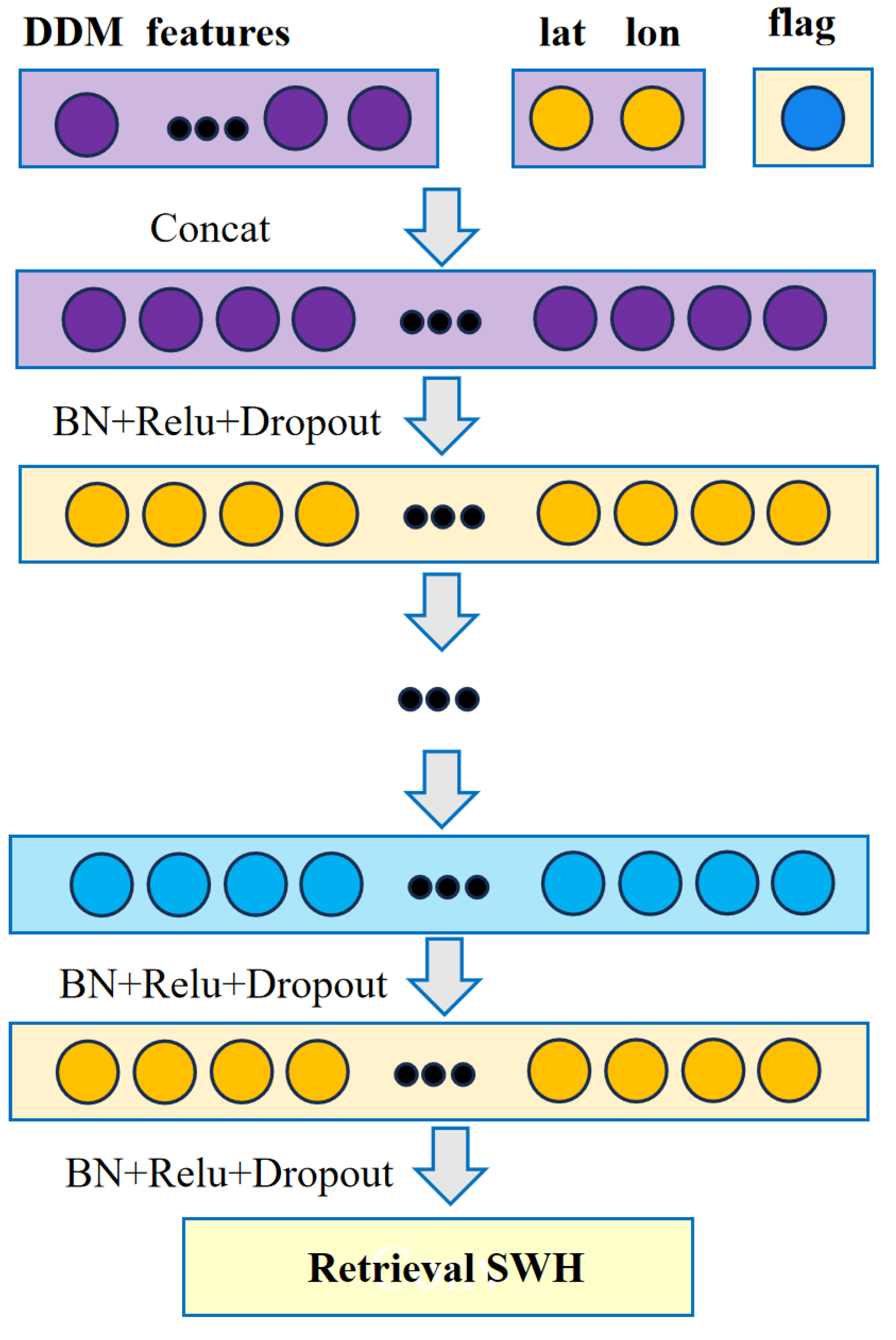
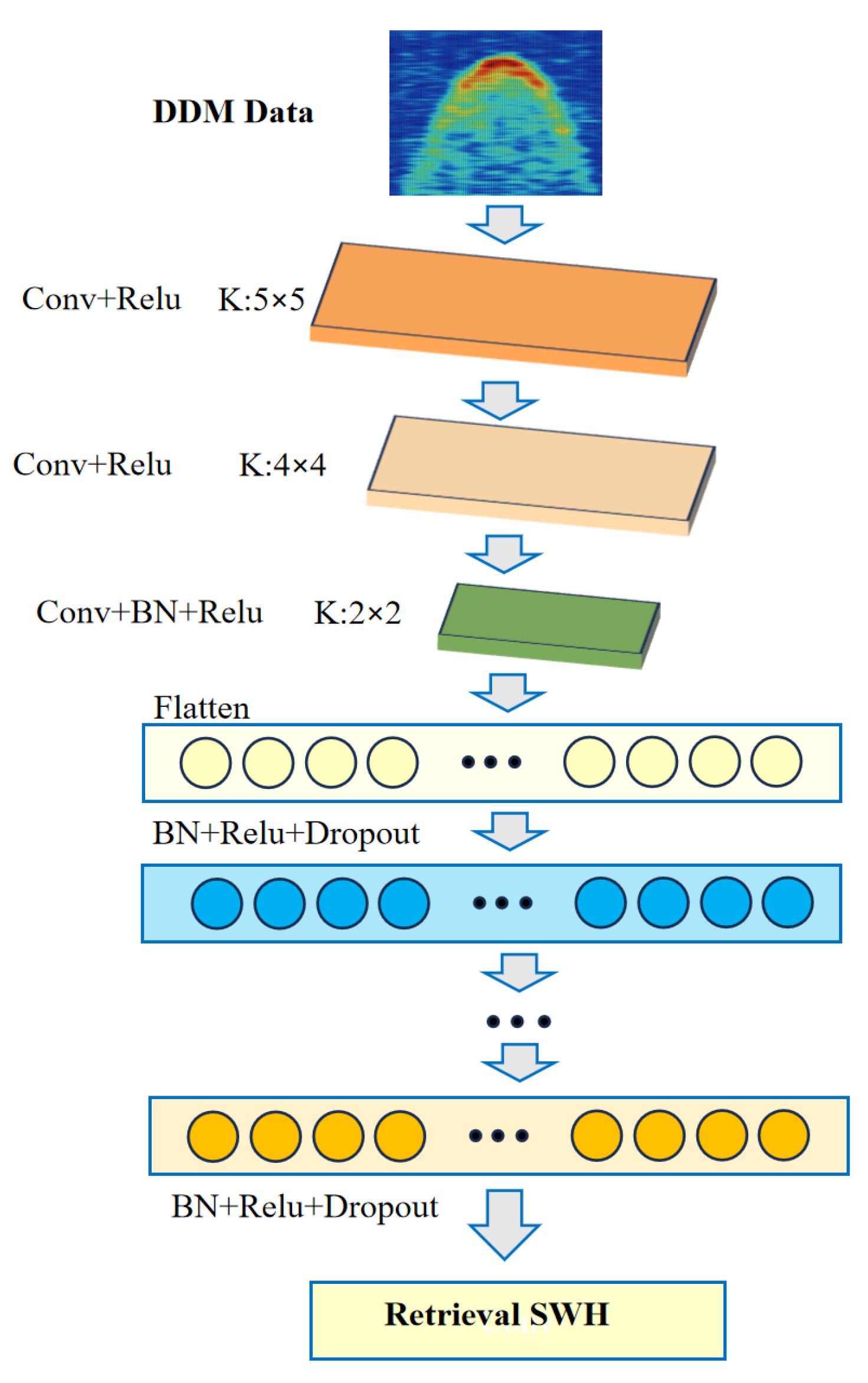
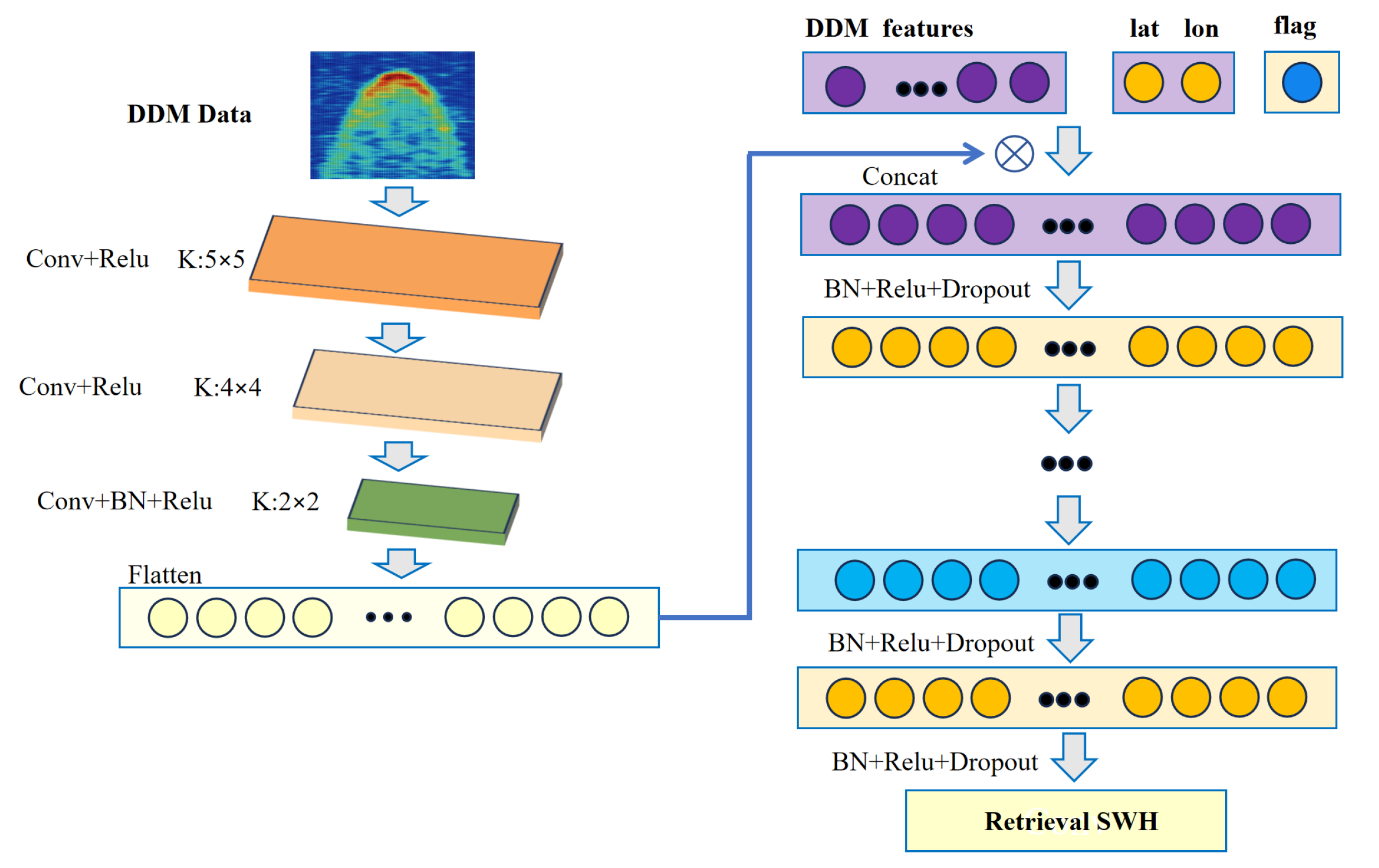
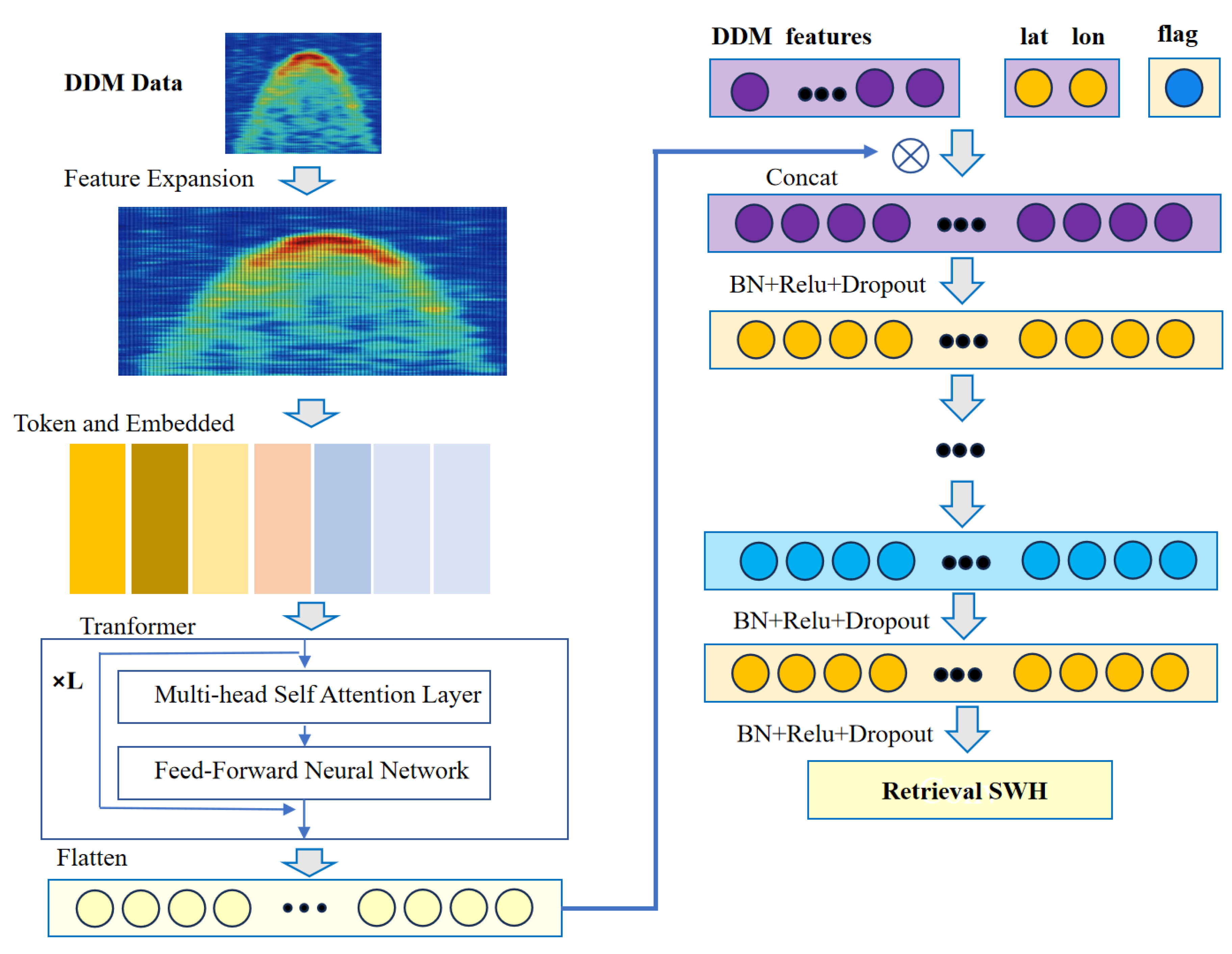
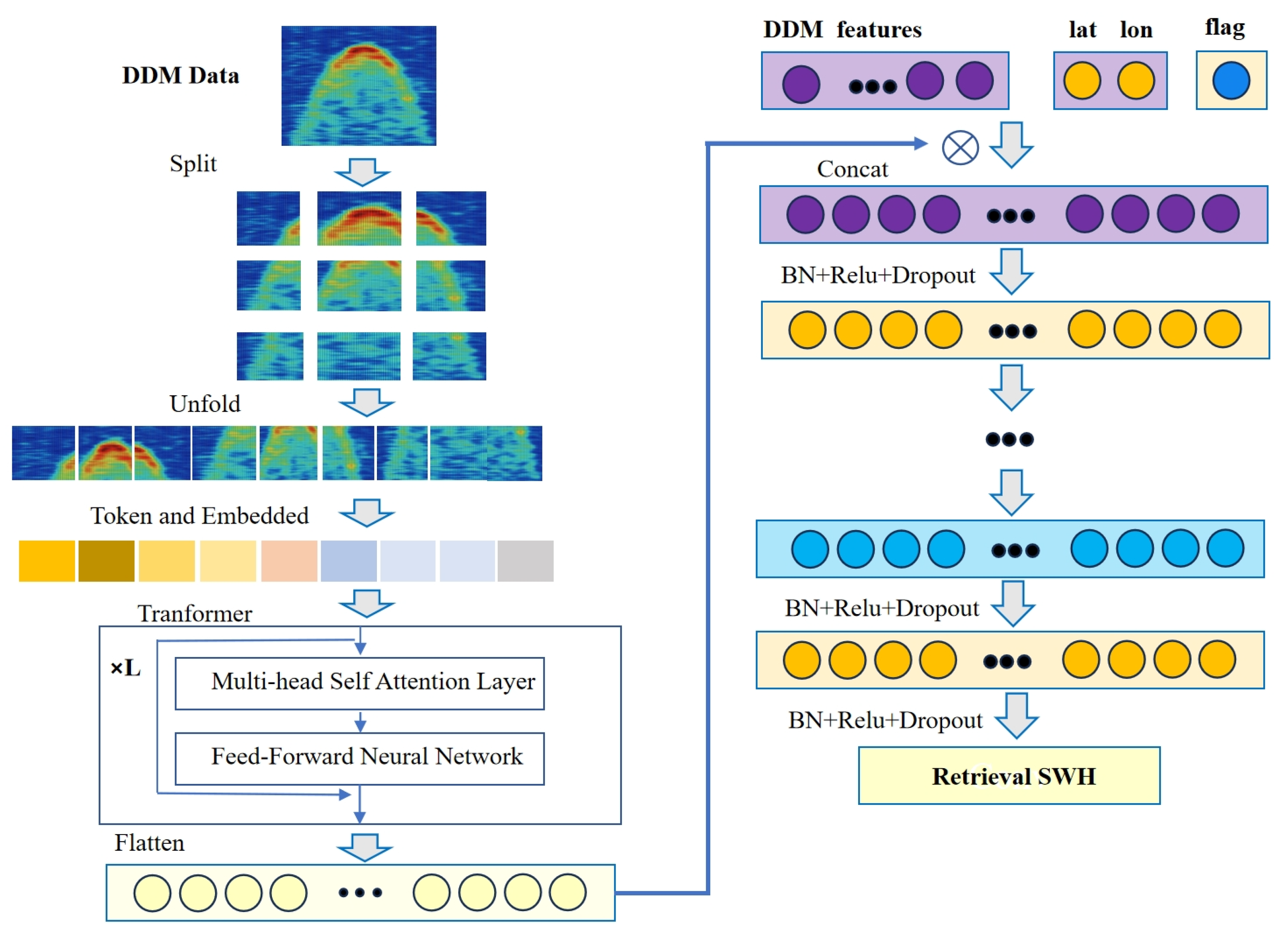
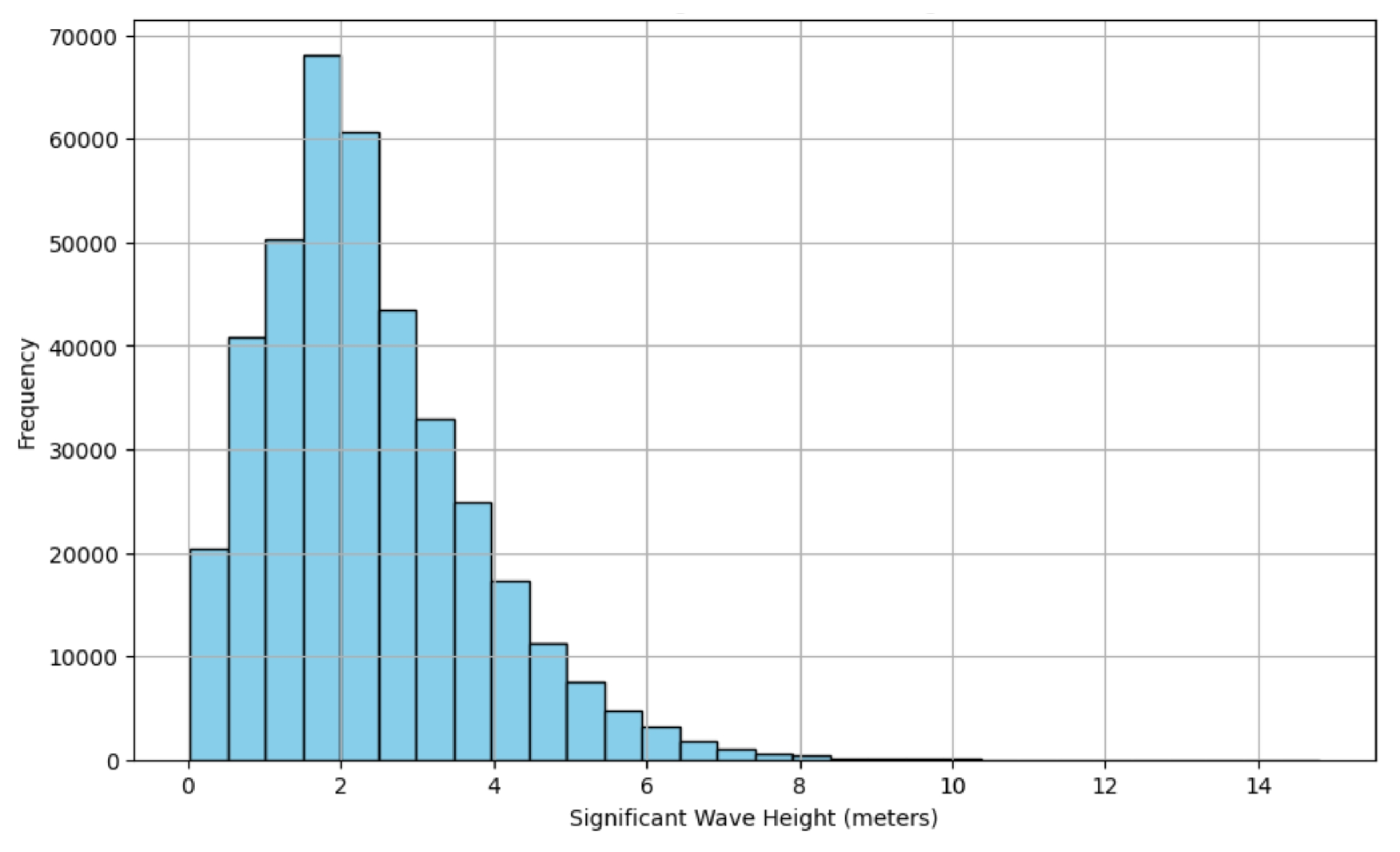
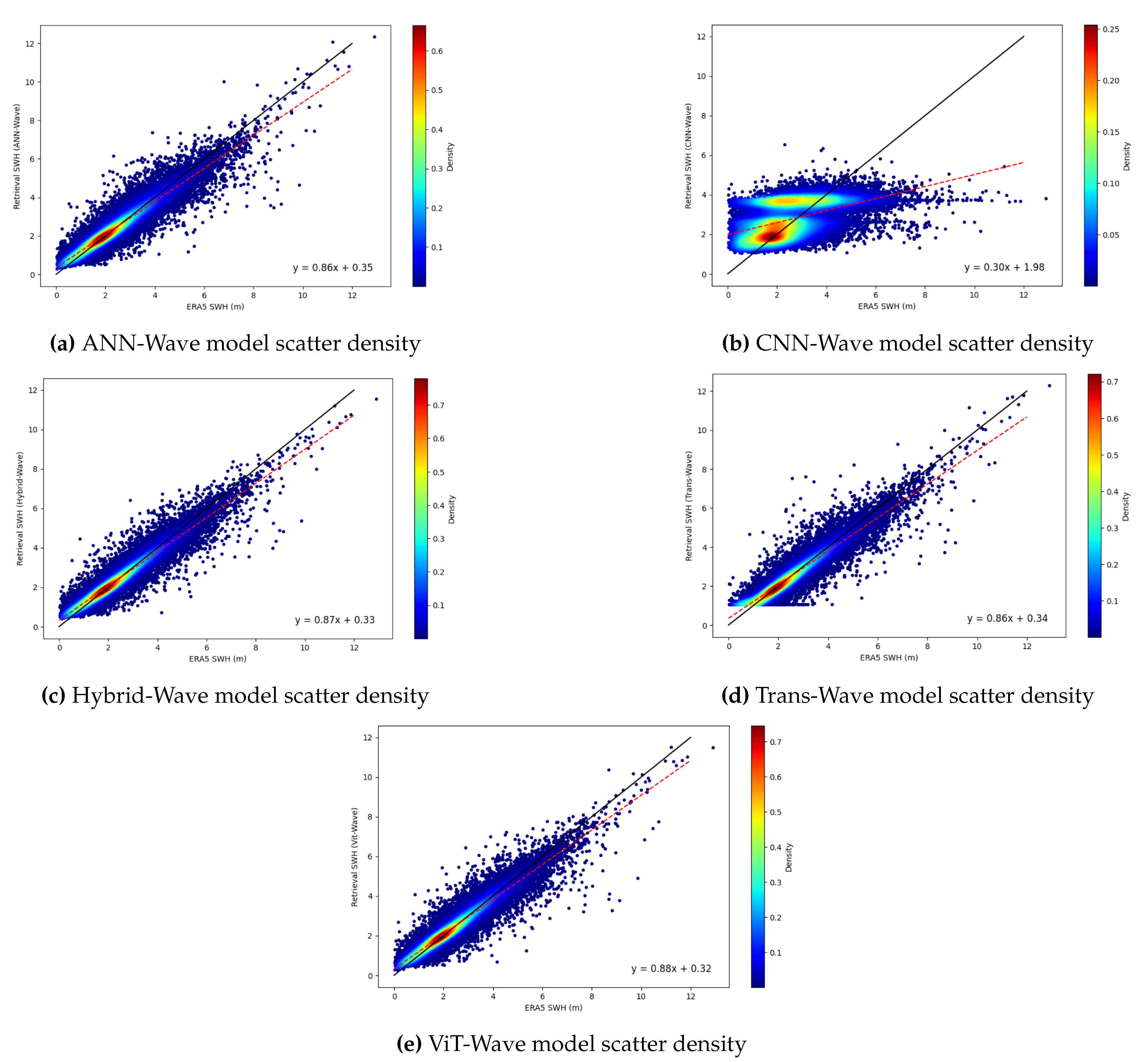
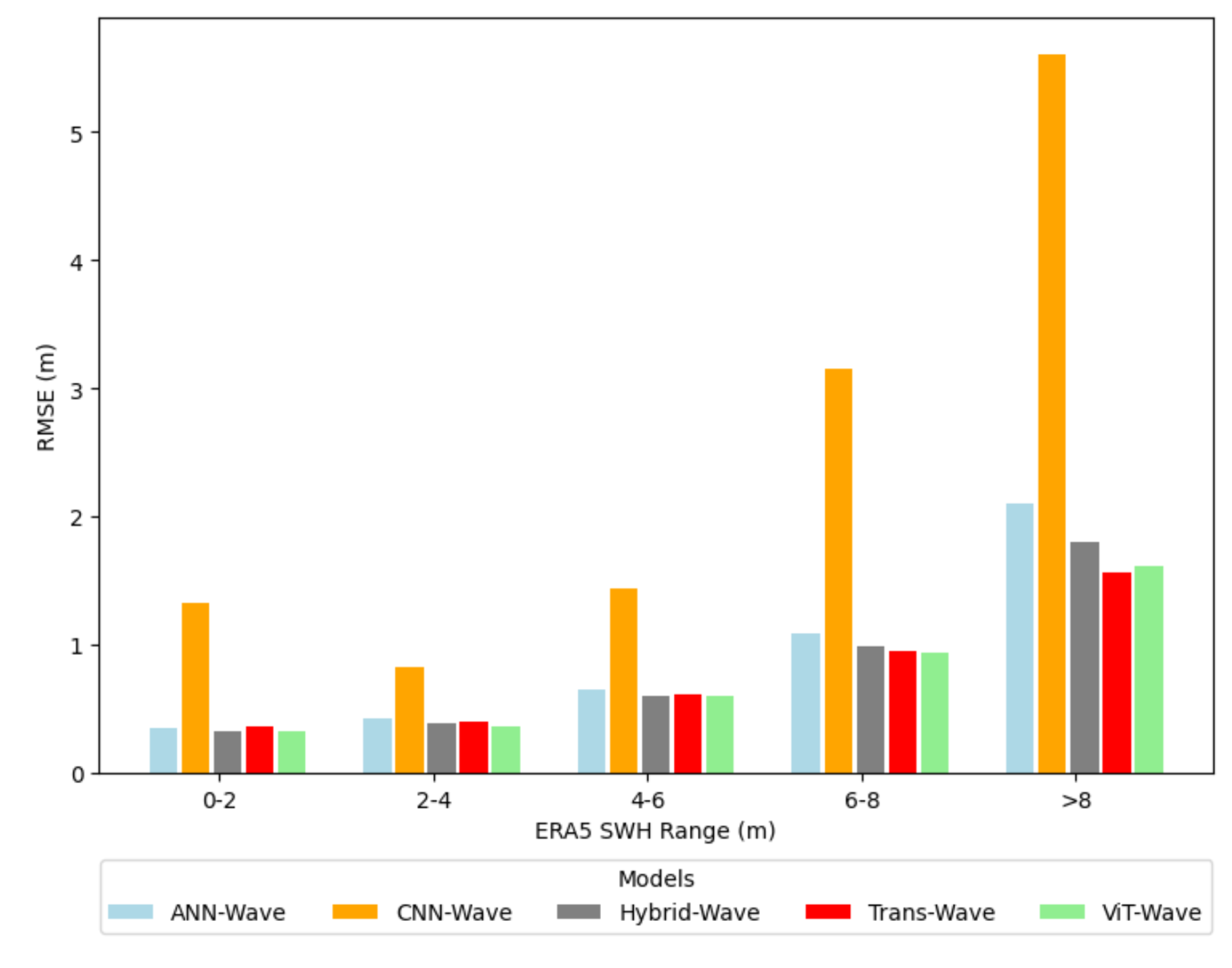
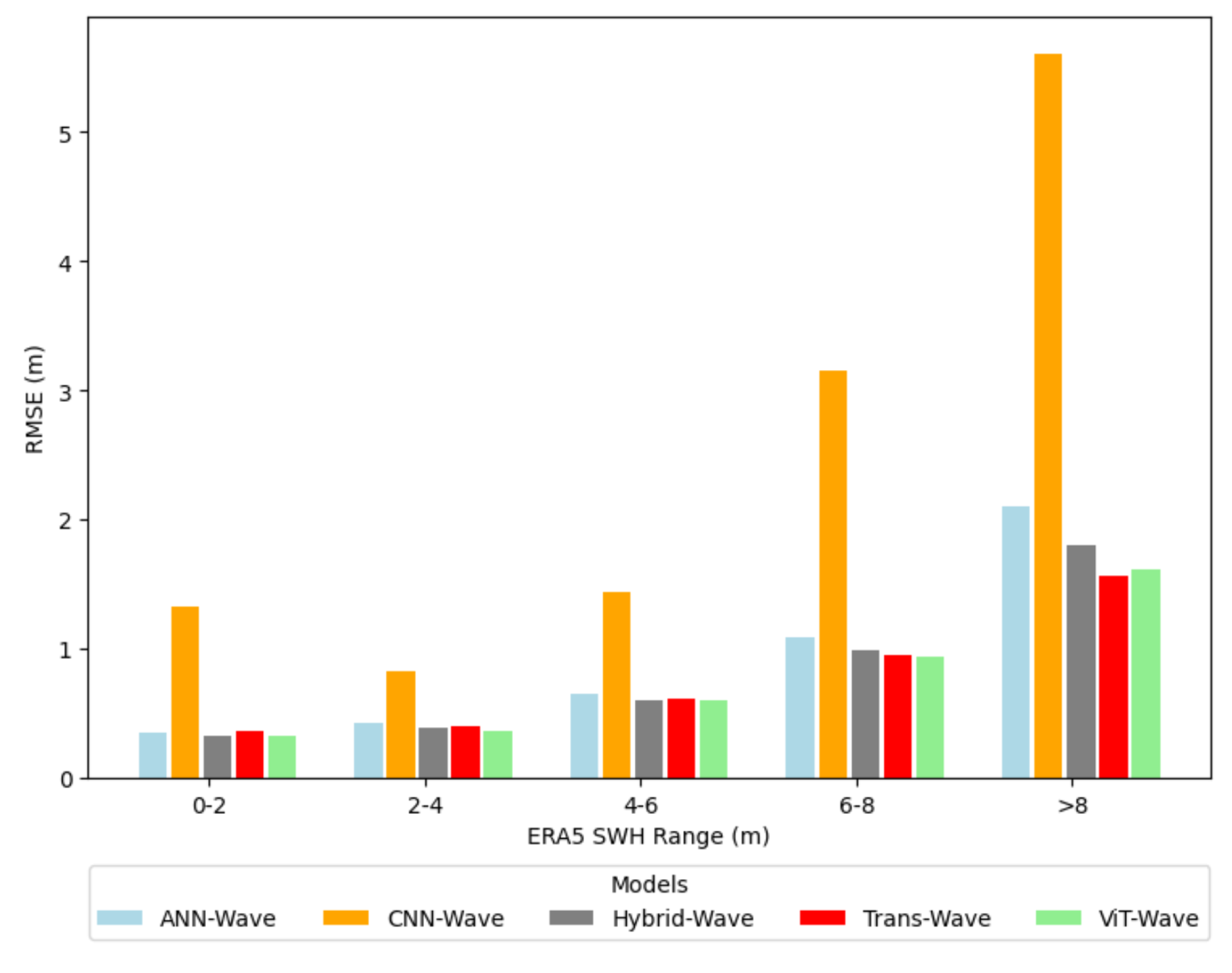
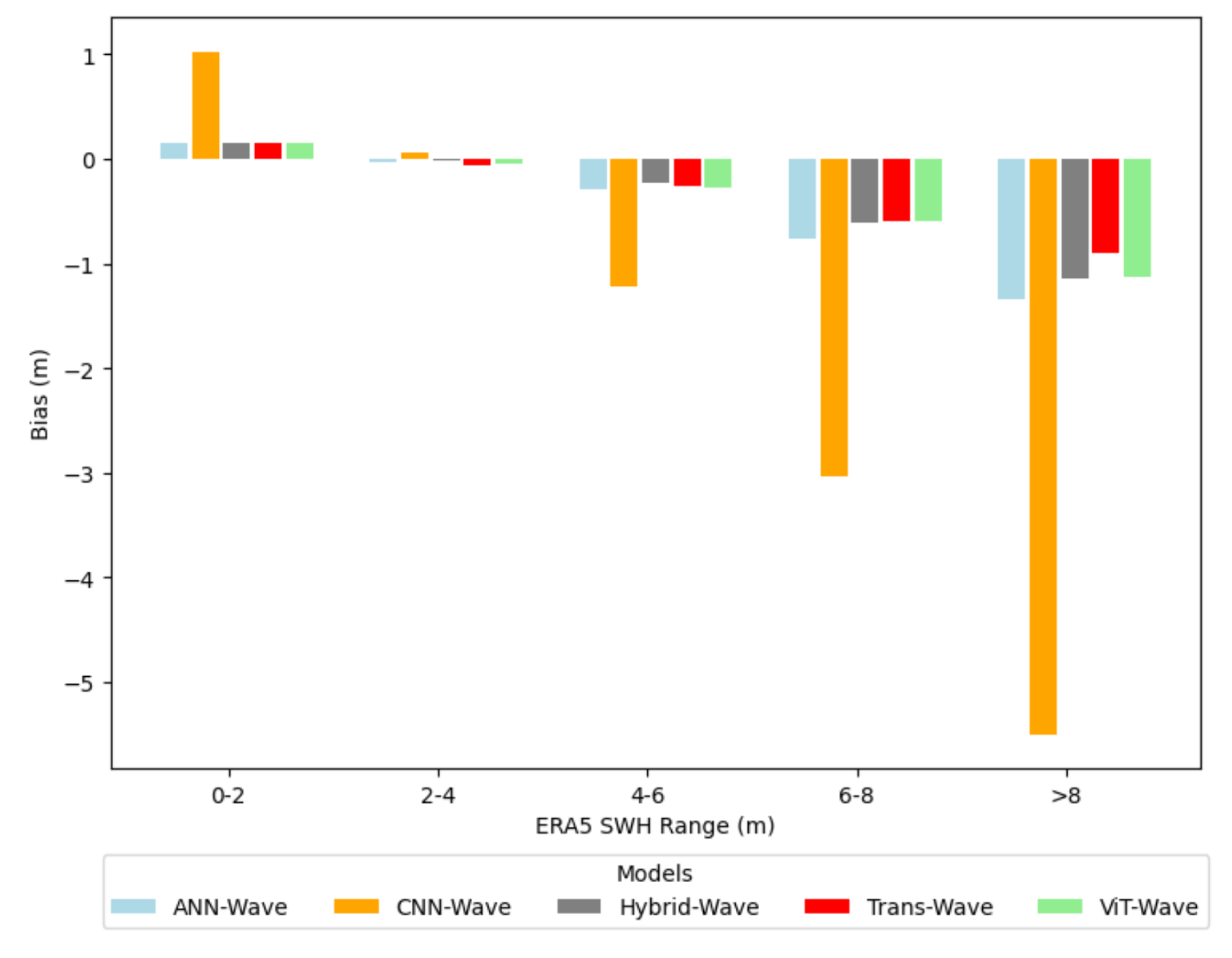
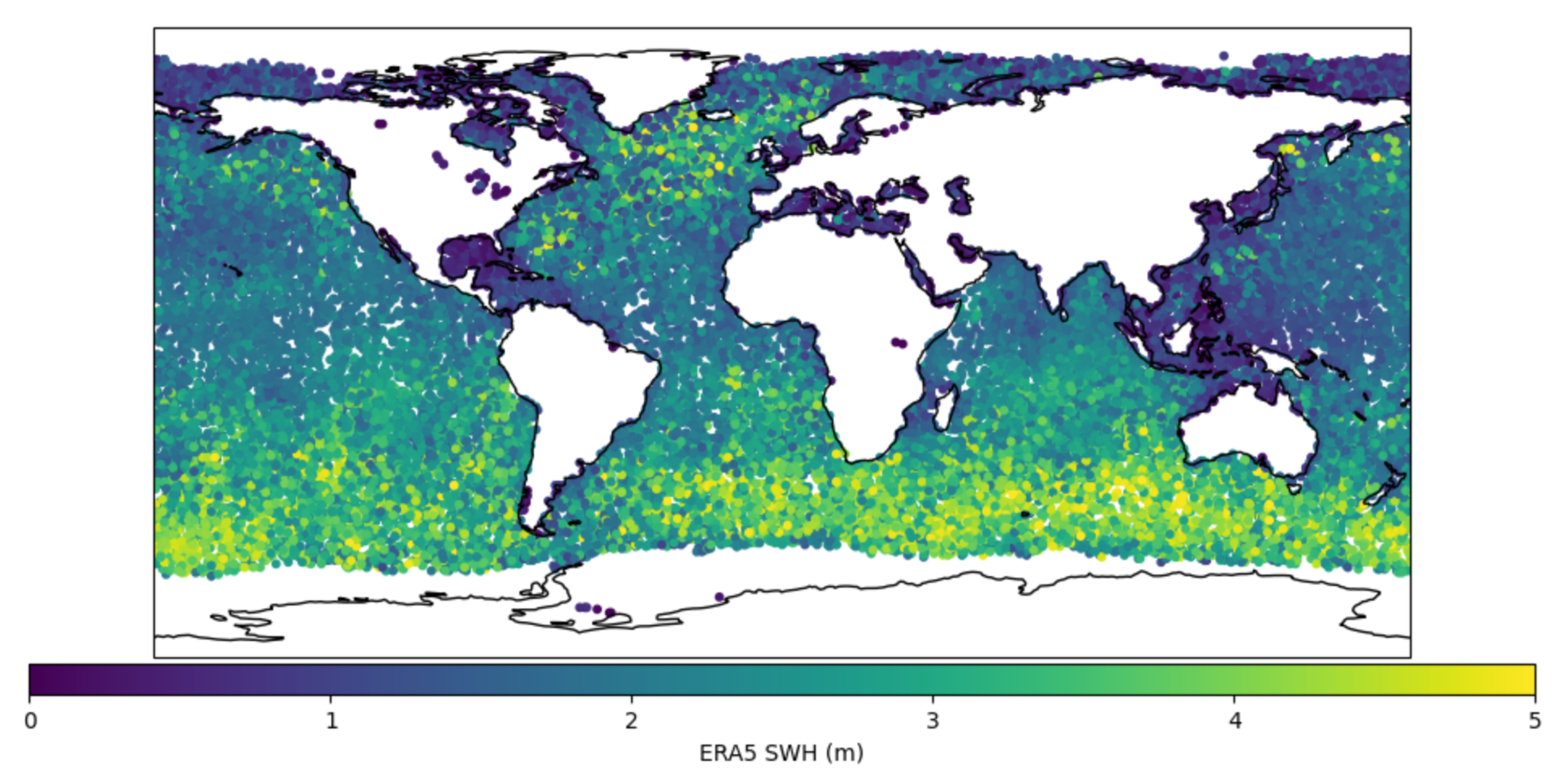
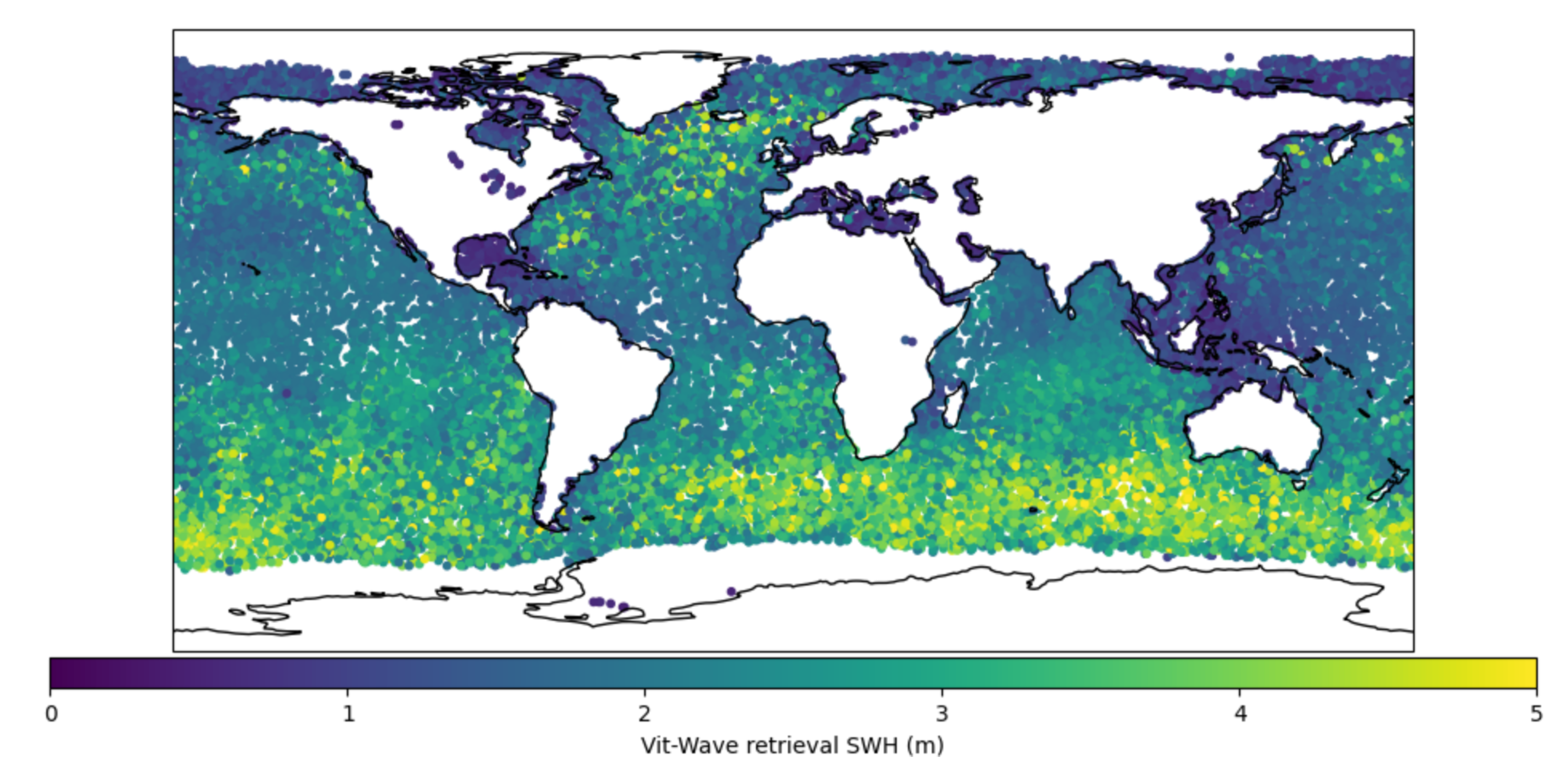
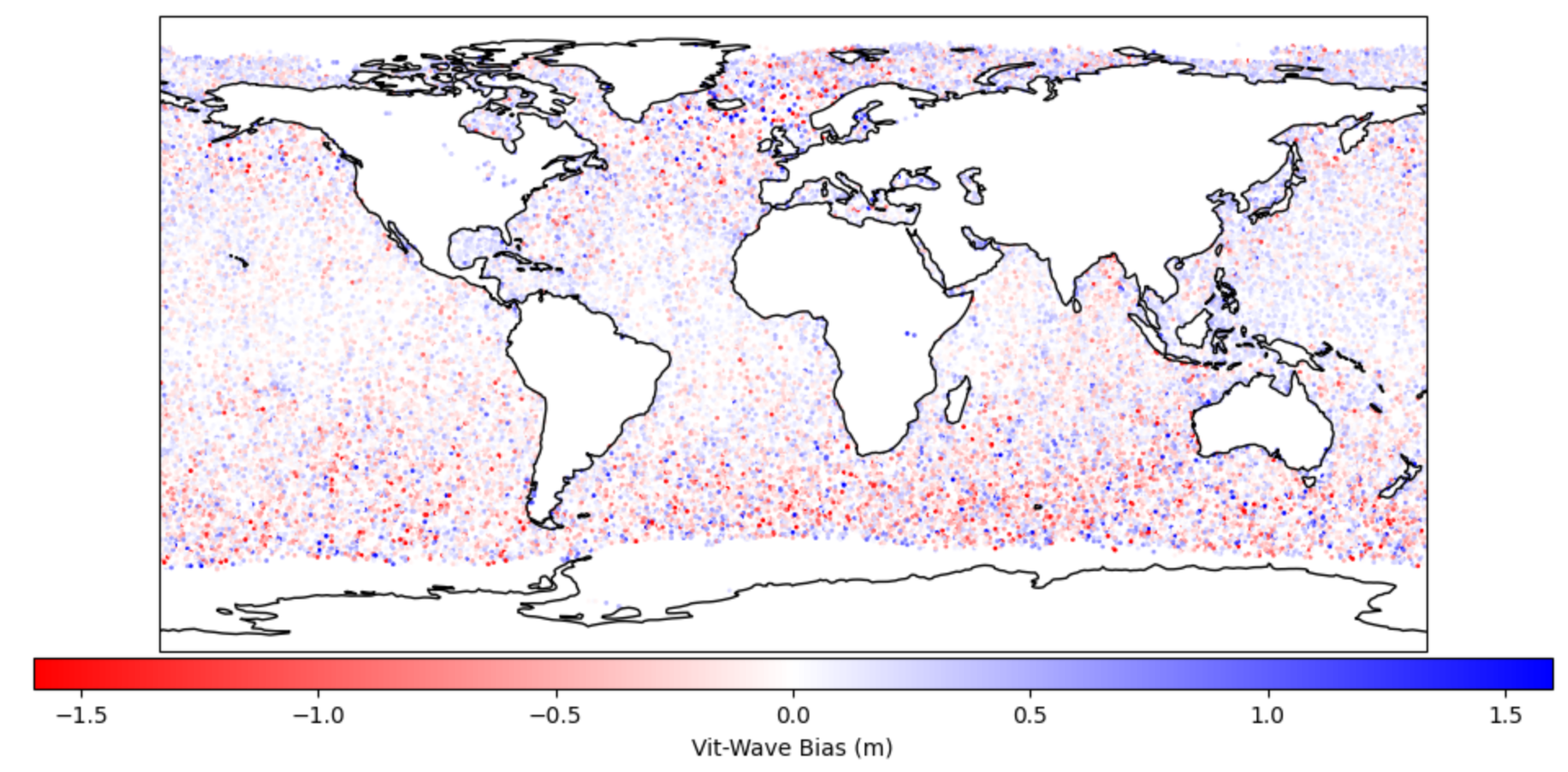
| Layer | ANN-Wave | CNN-Wave | Hybrid-Wave | trans-Wave | ViT-Wave |
|---|---|---|---|---|---|
| Convolutional Layers | |||||
| Conv2d | - | [128, 1, 5, 5] | [128, 1, 5, 5] | - | - |
| Conv2d | - | [32, 128, 4, 4] | [32, 128, 4, 4] | - | - |
| Conv2d | - | [1, 32, 2, 2] | [1, 32, 2, 2] | - | - |
| Transformer Layers | |||||
| Embedding | - | - | - | [20, 64] | [4 * 4, 64] |
| Transformer Encoder |
- | - | - | [64, 8, 3, 256] | [64, 8, 3, 256] |
| Linear Layer | |||||
| Linear | [31, 1000] | [12, 1000] | [43, 1000] | [(9 * 64) + 31, 1000] | [(45 * 64) + 31, 1000] |
| SWH Retrieval Layers | Weight Dimensions | ||||
| Linear | [1000, 2000] | ||||
| Linear | [2000, 1500] | ||||
| Linear | [1500, 500] | ||||
| Linear | [500, 200] | ||||
| Linear | [200, 100] | ||||
| Linear | [100, 10] | ||||
| Linear | [10, 1] | ||||
| Model | Train Loss ± Std | Validation Loss ± Std |
|---|---|---|
| ANN-Wave | 0.2135 ± 0.0146 | 0.2177 ± 0.0044 |
| CNN-Wave | 1.1400 ± 0.0191 | 1.9116 ± 0.6267 |
| Hybrid-Wave | 0.2065 ± 0.0165 | 0.1938 ± 0.0109 |
| Trans-Wave | 0.2034 ± 0.0148 | 0.1955 ± 0.0086 |
| ViT-Wave | 0.1816 ± 0.0040 | 0.1735 ± 0.0042 |
| RMSE | MAE | Bias | MAPE | R2 | |
|---|---|---|---|---|---|
| ANN-Wave | 0.4546 | 0.3048 | 0.0040 | 18.6814 | 0.8889 |
| CNN-Wave | 1.2337 | 0.9447 | 0.2715 | 74.6440 | 0.1819 |
| Hybrid-Wave | 0.4225 | 0.2799 | 0.0144 | 17.7126 | 0.9040 |
| Trans-Wave | 0.4344 | 0.2931 | -0.0012 | 23.2238 | 0.8986 |
| SNR[49] | 0.534 | 0.421 | - | 21.52 | - |
| NCDW LES[49] | 0.503 | 0.390 | - | 20.02 | - |
| ANN[32] | 0.59 | - | - | - | - |
| BT[32] | 0.48 | - | - | - | - |
| DCNN[37] | 0.422 | - | - | - | 0.89 |
| ViT-Wave | 0.4052 | 0.2700 | -0.0015 | 18.0200 | 0.9117 |
| RMSE | MAE | Bias | MAPE | R2 | |
|---|---|---|---|---|---|
| ANN-Wave | 10.85% | 11.45% | 137.50% | 3.54% | 2.57% |
| CNN-Wave | 67.15% | 71.42% | 100.55% | 75.86% | 401.10% |
| Hybrid-Wave | 4.10% | 3.53% | 110.42% | -1.74% | 0.83% |
| Trans-Wave | 6.72% | 7.88% | 25.00% | 28.28% | 1.46% |
| SNR[49] | 24.07% | 35.87% | - | 16.26% | - |
| NCDW LES[49] | 19.43% | 30.77% | - | 10.00% | - |
| ANN[32] | 31.36% | - | - | - | - |
| BT[32] | 15.62% | - | - | - | - |
| DCNN[37] | 4.00% | - | - | - | 2.44% |
| ViT-Wave | - | - | - | - | - |
Disclaimer/Publisher’s Note: The statements, opinions and data contained in all publications are solely those of the individual author(s) and contributor(s) and not of MDPI and/or the editor(s). MDPI and/or the editor(s) disclaim responsibility for any injury to people or property resulting from any ideas, methods, instructions or products referred to in the content. |
© 2024 by the authors. Licensee MDPI, Basel, Switzerland. This article is an open access article distributed under the terms and conditions of the Creative Commons Attribution (CC BY) license (http://creativecommons.org/licenses/by/4.0/).





